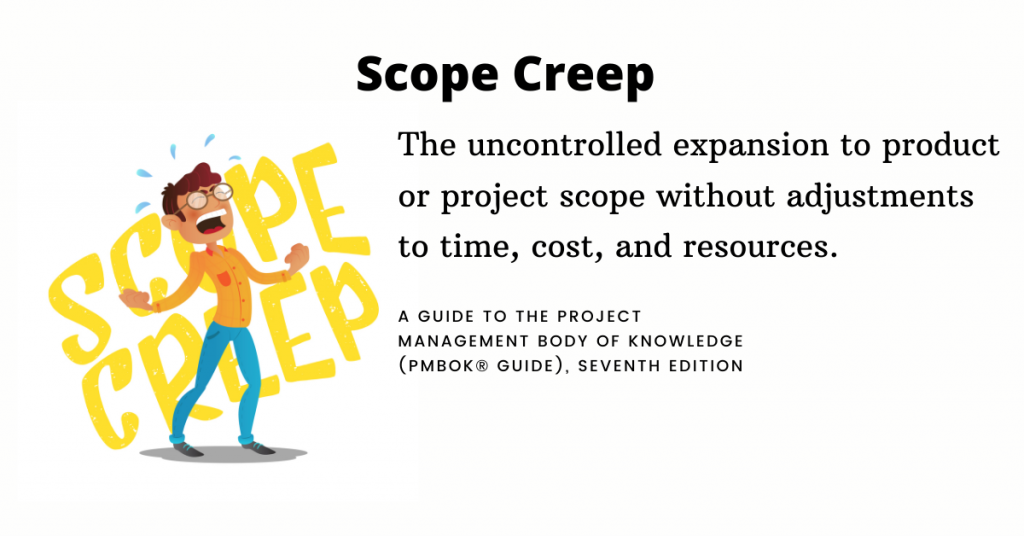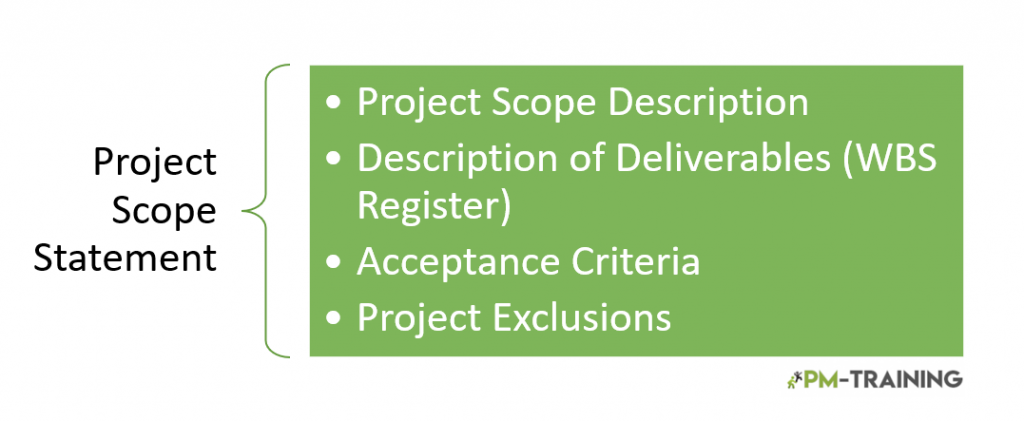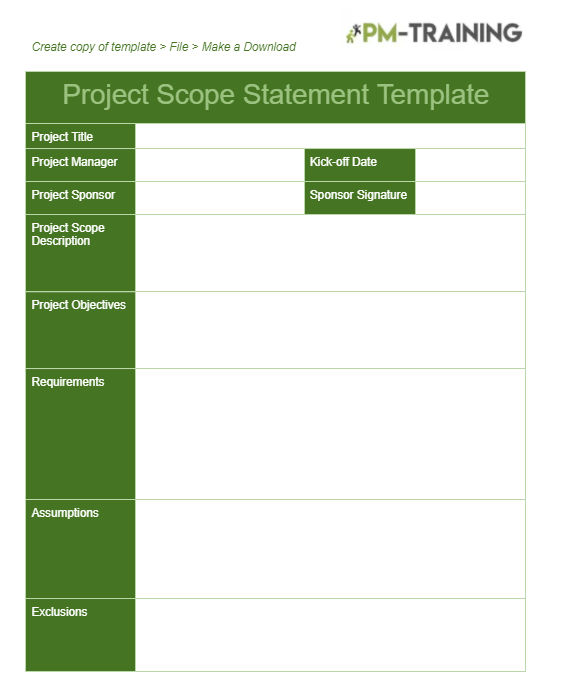A project scope definition is a comprehensive description of all project elements, including all related activities, assets, timeframes, milestones, and the project’s boundaries. The scope of a project also identifies essential players, processes, assumptions, and restrictions.
- Why Define Scope
- What Is Scope in Project Management
- How to Write Project Scope Document?
- 1. Recognize project kick-off date
- 2. Identify the project's primary objectives.
- 3. Create a statement of work for the project.
- 4. Determine the most critical requirements
- 5. Make a list of significant anniversaries. (assumptions)
- 6. Identify the significant roadblocks. (assumptions)
- 7. Create a list of scope exclusions.
- 8. Obtain a signature from sponsor
- Project Scope Definition FAQs
- Skills Needed to Define Scope.
Why Define Scope
The importance of project scope definition runs from benefiting stakeholders to the success of a project as a whole. A well-defined scope can assist in avoiding issues such as constantly changing requirements, requirements that need to be rethought in the middle of a project, having an end result the client was not hoping for and overspending on the budget. These changing requirements are called scope creep.

What is and is not included in a project’s scope is defined, and what can be added or withdrawn as it is carried out. Scope management creates control factors that can address elements that cause changes during the project’s lifecycle.
A well-defined scope also forms the basis for estimating the project’s resources, duration, and cost with higher accuracy. The scope of a project is the most critical piece of information that you must grasp entirely. Members of the project team with sufficient knowledge of building the product define the project scope.
It’s critical to define the scope early in a project’s life cycle because it can significantly impact the project’s schedule. Steps to defining scope.
Planning the scope – This process involves defining the boundaries and deliverables of the project.
Identifying stakeholder – gathering and determining requirements, and taking project drivers into account.
Scope documentation – Documentation is based on the project scope statement and gives a thorough rationale for the project’s goal. It outlines the project’s deliverables, objectives, and what must be done to meet those objectives.
Managing scope changes – Changes to the project’s scope are unavoidable. It’s vital to set up an effective scope management control system, especially for project scope issues.
What Is Scope in Project Management
Project Scope is the work that must be done to deliver a product, service, or result with the features and functionalities that have been specified. The term scope can be used in the context of a project to refer to product and project.

Project scope is all about the tasks that must be completed. Managing the project scope is primarily concerned with defining and controlling what is included and not included in the project.
Scope Baseline
The scope baseline is an approved version of a scope statement, WBS, and WBS dictionary, which can only be updated through formal change control procedures and is used as a comparison point.
Decomposition
Decomposition is a method for subdividing and breaking down a project’s scope and deliverables into smaller, more manageable parts. Decomposing a project’s complete work into work packages entails Identifying and assessing deliverables and associated work Organizing and structuring the WBS The upper WBS levels are broken down into lower-level detailed components.
The degree of control required to manage the project frequently determines the level of deconstruction efficiently. This is because the level of information for work packages varies depending on the project’s size and complexity.
Work Breakdown Structure (WBS)
The Work Breakdown Structure is a systematic breakdown of the scope of work that the project team must complete to meet the project’s objectives and produce the needed deliverables. The goal of a WBS is to make a large project more controllable. Breaking it down into smaller chunks allows work to be done simultaneously by different team members, leading to better team productivity and easier project management. It organizes and specifies the project’s overall scope and the work stated in the current authorized project scope statement.
Project Scope Statement
The primary goal of project scope management is to define and regulate what is and is not included in the project. According to the PMBOK. A scope statement is an integral part of any project plan, and it is where a Project scope is documented. It’s a written document used as the basis for project decisions down the line.
The scope statement clearly describes what is in scope. The project scope statement describes the project’s total scope, including project and product scope. It goes over everything in great depth on the project’s deliverables and makes sure that all project stakeholders know its scope.
Do’s and don’ts recommendations in the project scope statement
- Getting the customer involved is typically a good idea as it helps acquire a clear picture of their needs.
- Enlist the help of your stakeholders.
don’ts
- Make sure there are no uncertainties.
- Don’t add work to the project that isn’t necessary.
How to Write Project Scope Document?
Project managers are accountable for writing a thorough and complete scope of work statement. In every scope of the work document, you should include several standard elements. You’ll save yourself time by creating a standard template while ensuring your documents are always consistent and nothing is missed. Here are the steps how to write a project scope statement:
1. Recognize project kick-off date
Projects aren’t started in a vacuum; they’re started to achieve specific organizational goals. For example, a company may want to cut operational costs by the end of the year, enhance efficiency, or expand staff. The organization’s aims should be articulated in the project scope statement to the extent practicable.
2. Identify the project’s primary objectives.
Once project managers clearly understand the organization’s goals, they must identify the project’s specific goals. The objectives explain why executives chose and sponsored a project and justify its existence. While writing objectives, you should use SMART goal-setting best practices.
3. Create a statement of work for the project.
The statement of work lays out in detail the tasks that a project team will do. This process includes identifying and prioritizing targets and analyzing each potential target’s benefits and drawbacks. Assessing the company’s steps to enter each market and providing guidance and recommendations for critical decision-makers are all items in the scope of work for a project focused on creating an internal review of new markets to enter.
4. Determine the most critical requirements
Project managers should collaborate with key stakeholders to create a list of the items to be delivered at the end of the project. You can state these items at a high level in the project scope statement. A new market evaluation report, for example, must still be concrete and measurable targets. The work detail structure, a separate document, will detail the precise actions connected with each deliverable.
5. Make a list of significant anniversaries. (assumptions)
A significant milestone specifies when a special delivery will be finished and can be expected by stakeholders. You may include milestones for specific actions to develop or complete a deliverable in more complicated projects.
6. Identify the significant roadblocks. (assumptions)
When writing a scope statement,you should note any limits that the project team will experience to complete a project,whether personnel, resources, or other criteria.
7. Create a list of scope exclusions.
This list includes deliverables that a project sponsor may believe are included in the project’s scope but are not. A project sponsor, for example, may believe that a project to construct a management system also includes certification of the system. The project scope statement should specify whether the system will be certified by the project team or whether the sponsor will be responsible for getting certification after the project is completed.
8. Obtain a signature from sponsor
Having key stakeholders sign the project scope statement confirms that they know and comprehend its contents. Obtaining a sign off helps project managers and organizations save time, money, and stress by avoiding miscommunication that might causing rework to be done during or after the project
Project Scope Definition FAQs
How do you define project scope?
The process of identifying and recording a list of specified project goals, deliverables, tasks, costs, and deadlines is known as the project scope.
What is a project scope example?
Project scope example a valuable tool in project management for explaining the project’s most significant deliverables, such as milestones, assumptions, and limits.
Why is it important to define the project scope?
Project scope defining is essential because project managers would have no idea how much time, money, or labor a project would require.
What are the 5 steps of defining scope?
1: Define the objectives,
2: Identify potential roadblocks,
3: Identify required resources,
4: Provide a timeline, and
5: List the stakeholders.
What is project scope PMP?
The project management plan specifies how the scope will be specified, developed, monitored, controlled, and validated. Project scope is the ultimate aspect of a project that needs to be elaborated upon without uncertainty. Project Scope becomes the foundation for estimating the project timelines and project cost. Once the project scope is defined and agreed upon, any change after that will impact the agreed project time and cost.
Skills Needed to Define Scope.
Gather Expert Judgment
Expertise from persons or organizations with similar initiatives, knowledge, or experience should be considered when defining scope. When doing this you can try out a scope statement mindmap to help gather the information.
Analysis of Project Data
Alternatives analysis is an example of a data analysis technique employed in this process. Alternatives analysis can analyze different approaches to meeting the charter’s requirements and objectives.
Multicriteria Decision Analysis
Multi-criteria decision analysis technique employs a decision matrix to provide a systematic analytical strategy for generating criteria such as requirements, schedule, and resources to fine-tune the project’s and product’s scope.
Interpersonal and Team Skills
Facilitation is an example of an interpersonal and team skills technique. In workshops and working sessions involving essential stakeholders who have a variety of expectations or domains of expertise, facilitation is employed. The goal is to achieve a cross-functional understanding of project deliverables and product boundaries.
Analysis of Products and Services
This technique can define products and services. It entails posing questions about a product or service and formulating responses that characterize its application, qualities, and other vital aspects. Requirements are gathered at a high level and then broken down to the level of detail required to create the final product.

